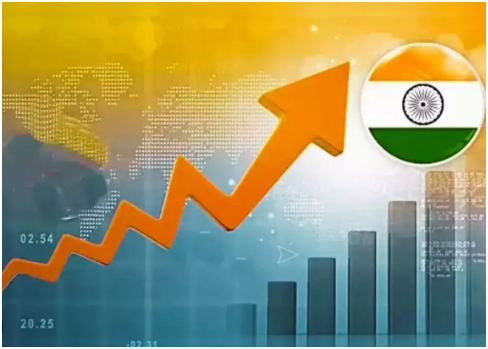RBI has expressed concerns over inflation risks but maintained an optimistic growth outlook, projecting a GDP growth rate of 7.2% for the financial year 2024-25.
This forecast reflects the central bank’s confidence in the resilience of the Indian economy, driven primarily by robust manufacturing and services sector activity. The RBI’s policy stance suggests a fine balancing act between curbing inflationary pressures and sustaining economic momentum amid global uncertainties and domestic challenges.
The RBI’s latest projection underscores the strength of India’s economic fundamentals, with key sectors like manufacturing, construction, and information technology contributing significantly to the country’s growth trajectory. The positive growth outlook is also bolstered by improved consumer sentiment, rising exports, and sustained investments in infrastructure development. Private consumption, which has been a key driver of growth, is expected to remain strong as rising incomes and urbanization continue to boost domestic demand.
However, the RBI has cautioned that inflationary pressures could pose challenges to maintaining economic stability. Although inflation has eased slightly in recent months, volatile food prices and external factors, such as global commodity price fluctuations, remain significant risks. The central bank highlighted the importance of close monitoring, particularly with the potential for adverse weather conditions and geopolitical tensions to disrupt supply chains. The RBI’s inflation forecast remains slightly above the comfort zone, suggesting that inflation could linger within the 5-6% range in the near term.
Monetary policy will play a crucial role in balancing these inflation risks with the need to support growth. While the central bank has opted to keep key interest rates unchanged for now, it has indicated a readiness to take appropriate measures if inflationary pressures intensify. The RBI’s cautious approach reflects a desire to maintain price stability without stifling economic recovery. Market analysts believe that the central bank is likely to maintain its current stance until there is greater clarity on inflation dynamics, while keeping an eye on global developments, including oil prices and monetary policy shifts in major economies.
India’s manufacturing sector has shown promising signs of recovery, supported by the government’s production-linked incentive (PLI) schemes aimed at boosting domestic production and exports. The sector has benefited from increased investments in technology and a shift towards sustainable practices, making Indian manufacturers more competitive in global markets. Meanwhile, the services sector, which accounts for a significant share of GDP, has continued to grow steadily, driven by the IT, financial services, and hospitality industries.
The RBI also emphasized the importance of fiscal policy alignment to support economic growth. Public spending on infrastructure projects and social programs has provided a crucial stimulus, helping create jobs and improve overall productivity. With a focus on infrastructure development, including highways, railways, and digital connectivity, the government’s initiatives are expected to complement private sector efforts and create a conducive environment for sustained economic growth.
Foreign direct investment (FDI) flows into India have remained strong, further validating the positive growth outlook. The country’s attractiveness as an investment destination has been bolstered by policy reforms, including measures to ease regulatory processes and improve the ease of doing business. Key sectors such as renewable energy, pharmaceuticals, and electronics manufacturing have attracted substantial investments, reinforcing India’s position as a global economic player.
The central bank’s growth projection also reflects optimism about the rural economy, which has benefited from increased agricultural production and favorable monsoon conditions. With agriculture contributing significantly to employment and rural income levels, any improvement in this sector has a direct impact on overall economic growth. The government’s efforts to enhance farm productivity, improve irrigation infrastructure, and promote agro-based industries are expected to yield positive results, further strengthening rural demand.
Despite the positive outlook, the RBI has acknowledged several downside risks, including potential disruptions in the global economy, fluctuations in crude oil prices, and the impact of tighter monetary policies by other central banks. The ongoing geopolitical tensions in various parts of the world also pose risks to global trade and financial stability, which could indirectly affect India’s growth prospects.
Nonetheless, the RBI’s projection of 7.2% GDP growth for 2024-25 reflects confidence in India’s ability to navigate these challenges. The central bank’s optimistic outlook aligns with recent data suggesting a broad-based recovery across multiple sectors. Unemployment levels have gradually declined, and credit growth has picked up, indicating increased economic activity and business confidence. Additionally, India’s foreign exchange reserves remain robust, providing a buffer against external shocks.
To sustain this growth momentum, the RBI has stressed the need for continued structural reforms and policy support. It highlighted the importance of digital transformation and financial inclusion initiatives, which are expected to drive economic progress and ensure equitable growth. The central bank also emphasized the need for banks to strengthen their capital base and improve asset quality to support credit growth and reduce financial risks.
Market participants have responded positively to the RBI’s growth projection, viewing it as a signal of economic resilience despite global uncertainties. The central bank’s focus on inflation management without compromising growth has reassured businesses and investors, boosting market sentiment. Stock markets have reflected this optimism, with key indices registering gains following the RBI’s announcement.
Looking ahead, the RBI remains committed to fostering a stable economic environment that supports sustainable growth and job creation. The central bank reiterated its focus on maintaining financial stability and ensuring adequate liquidity to support credit flow to productive sectors. As India continues to position itself as a global economic powerhouse, the RBI’s policy framework will play a crucial role in ensuring that growth is inclusive, sustainable, and resilient to future challenges.
With a positive growth trajectory backed by strong sectoral performance, increasing investments, and sound macroeconomic policies, India is well on its way to achieving its ambitious GDP target for 2024-25. While inflation risks remain a concern, the RBI’s proactive approach and coordinated efforts with the government are expected to mitigate these challenges effectively. The growth projection of 7.2% not only reflects confidence in India’s economic fundamentals but also signals the country’s potential to emerge stronger in a rapidly evolving global landscape.
